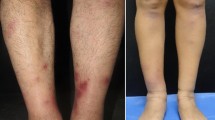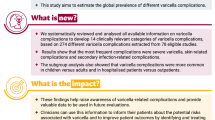Abstract
Background
To study the efficacy and safety of subcutaneous botulinum toxin A injections in the treatment of primary and recurrent chalazia.
Methods
Prospective, placebo-controlled consecutive case-series trial. Sixty three patients were divided into two groups: group 1 consisting of 32 patients previously diagnosed with and treated for primary or recurrent chalazia with 2–5 international units (IU) in 0.2–0.5 ml of preserved saline solution of botulinum toxin injection, and group 2 consisting of 31 patients receiving placebo. The main outcome measures were localization and duration of the disease, size of chalazion before and after treatment, clinical resolution of chalazion, time to resolution, and complications of treatment.
Results
There was a clinically and statistically significant between-group difference in the rate of therapeutic success and post-therapeutic chalazion regression, but not in the rate of complications.
Conclusions
Botulinum toxin A injection is effective and safe treatment for primary and recurrent chalazia. Lesion regression that did not respond to the average of two injections would benefit more from surgical excision or systemic antibiotic therapy.



Similar content being viewed by others
References
Dhaliwal U, Arora VK, Singh N, Bhatia A (2004) Cytopathology of chalazia. Diagn Cytopathol 31(2):118–122. doi:10.1002/dc.20092
Lempert SL, Jenkins MS, Brown SI (1979) Chalazia and rosacea. Arch Ophthalmol 97(9):1652–1653 Sep
Dua HS, Nilawar DV (1982) Nonsurgical therapy of chalazion. Am J Ophthalmol 94:424–425
Perry HD, Serniuk RA (1980) Conservative treatment of chalazia. Ophthalmology 87:18–21
Pizzarello LD, Jakobiec FA, Hofeldt AJ et al (1978) Intralesional corticosteroid therapy of chalazia. Am J Ophthalmol 85:818
Watson AP, Austin DJ (1984) Treatment of chalazion with injection of a steroid suspension. Br J Ophthalmol 68:833. doi:10.1136/bjo.68.11.833
Ben Simon GJ, Huang L, Nakra T et al (2005) Intralesional triamcinolone acetonide injection for primary and recurrent chalazia: is it really effective? Ophthalmology 112:913–917. doi:10.1016/j.ophtha.2004.11.037
Epstein GA, Putterman AM (1988) Combined excision and drainage with intralesional corticosteroid injection in the treatment of chronic chalazia. Arch Ophthalmol 106:514–516
Chung CF, Lai JS, Li PS et al (2006) Subcutaneous extralesional triamcinolone acetonide injection versus conservative management in the treatment of chalazion. Hong Kong Med J 12(4):278–281
Dutton JJ, Fowler AM (2007) Botulinum toxin in ophthalmology. Surv Ophthalmol 52(1):13–31. doi:10.1016/j.survophthal.2006.10.003
Turton K, Chaddock JA, Acharya KR et al (2002) Botulinum and tetanus neurotoxin structure, function and therapeutic utility. Trends Biochem Sci 27:552–558. doi:10.1016/S0968–0004(02)02177–1
Glogau RG (2002) Review of botulinum toxin for hyperhidrosis and cosmetic purposes. Clin J Pain 18:191–197. doi:10.1097/00002508–200211001–00012
Kinkelin I, Hind M, Naumann M et al (2000) Effective treatment of frontal hyperhidrosis with botulinum toxin A. Br J Dermatol 143:824–827. doi:10.1046/j.1365–2133.2000.03839.x
Perra MT, Serra A, Sirigu P, Turno F (1996) Histochemical demonstration of acetyl cholinesterase activity in human meibomian gland. Eur J Histochem 40(19):39–44
Aisa J, Lahoz M, Serrano P, Pérez-Castejón MC, Junquera C, Martinez-Ciriano MC, Pes N, Vera-Gil A (2001) Acetylcholinesterase-positive and paraformaldehyde-induced-fluorescence-positive innervation in the upper eyelid of the sheep (Ovis aries). Histol Histopathol 16(2):487–496
Chung CW, Tigges M, Stone RA (1996) Peptidergic innervation of the primate meibomian gland. Invest Ophthalmol Vis Sci 37(1):238–245
Prasad S, Gupta AK (1992) Subconjunctival total excision in the treatment of the chronic chalazia. Indian J Ophthalmol 40:103–106
Thomas EL, Laborde RP (1986) Retinal and choroidal vascular occlusion following intralesional corticosteroid injection of chalazion. Ophthalmology 93:405–407
Procope JA, Kidwell ED Jr (1996) Delayed postoperative hemorrhage complicating chalazion surgery. J Natl Med Assoc 86:865–866
Author information
Authors and Affiliations
Corresponding author
Additional information
The authors have no financial interests in this study. The authors have full control of all primary data and they allow Graefe’s Archive for Clinical and Experimental Ophthalmology to review data of study.
Rights and permissions
About this article
Cite this article
Knezevic, T., Ivekovic, R., Pavicic Astalos, J. et al. Botulinum toxin A injection for primary and recurrent chalazia. Graefes Arch Clin Exp Ophthalmol 247, 789–794 (2009). https://doi.org/10.1007/s00417-008-0992-3
Received:
Revised:
Accepted:
Published:
Issue Date:
DOI: https://doi.org/10.1007/s00417-008-0992-3




